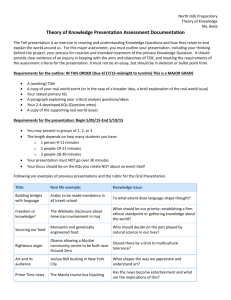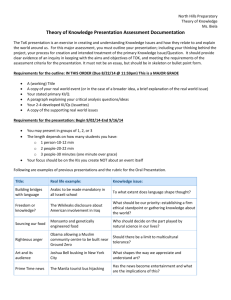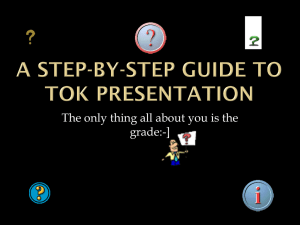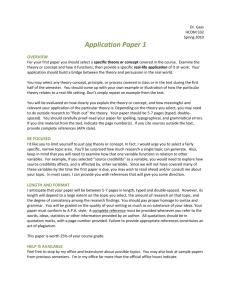Presentations – Feedback from 2013 Examiners Report
advertisement
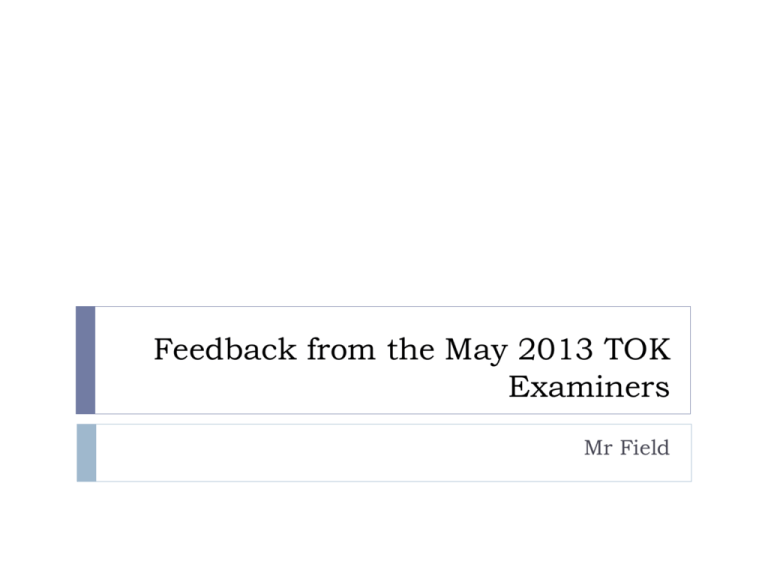
Feedback from the May 2013 TOK Examiners Mr Field The Presentation Is…. Somewhere to discuss important knowledge issues in the context of a real-life situation Somewhere to explore your own ideas about knowledge and the way knowledge is generated and shaped A lesson that should make a genuine contribution to your classmates’ understanding The Presentation Is Not… A forum to debate a contentious issue such as: Is abortion right or wrong? Is the death penalty acceptable? Should violent videogames be banned? You could turn the above into knowledge issues (although they often won’t be great ones), for example: How should we decide X? What role should X play in deciding Y? The Real Life Situation Must be concrete If you can’t answer who, what, why, when, where questions, then it is probably not concrete Must be real and not hypothetical Real and recent events (where you have direct experience), lend themselves better to exploration than abstract events: A real-life situation based on a conversation you had, or a lesson you experienced is generally better than one based on a book you read or a broad topic such as same-sex marriage (which you probably haven’t experienced!) Should refer implicitly or explicitly to a knowledge claim The Knowledge Issue Must be stated explicitly Must be clearly linked to real life situation You probably want to explain to the audience how you got from your RLS to your KI Needs to refer to the way knowledge is acquired and shaped not the knowledge itself. About the knowledge itself: About acquiring and shaping knowledge: Is abortion right or wrong? What role should reason play in reaching ethical conclusions? Should be a single knowledge issue, not multiple knowledge issues Sometimes, in order to fully address your KI, it will be necessary to ask and answer other smaller ones. This is fine, but they must be relevant and necessary in order to address the main one. For example…. Real life situation Knowledge issue Attempted assassination of Pakistani girl Malala Yousafzai for promoting girls’ education. Why do we need a tragedy before we act on knowledge that we have? Renaming of cities in India To what extent do labels affect our perception? Article on climate change To what extent is a scientific explanation more convincing than other types of explanation? UN warns of looming food crisis in 2013 How do we know what is a fact? Bullfighting ban in Catalonia How can we know when a tradition should be upheld? The Ekeko amulet of the Andean Altiplano believed to bring monetary wealth to its worshipper. Why do people hold beliefs for which there is no evidence? Wiki Leaks and the publication of secret information and news leaks. To what extent is emotion a better guide to what is ethical than reason? Salvador Dalí, an eccentric person To what extent does it matter to know about an artist to understand his or her art? Criterion A: Identification of Knowledge Issues The big mistakes here are: Poor real-life situation: Not concrete, not real, not personal and relevant to the student Poor knowledge issue: Interesting question, but not a knowledge issue Not relevant to the real-life situation Doesn’t use appropriate TOK vocabulary Criterion B: Treatment of Knowledge Issues The biggest mistake here is to describe but not analyse You should: Talk about the bits of the syllabus relevant to your knowledge issue, for example: relevant ways of knowing, areas of knowledge Say what that means for the knowledge issue you are trying to address Most people do the first part, but not the second part. When you talk about anything you should ask: ‘so what?’…that should help you focus on the analysis needed Criterion C: Knower’s Perspective This is not about asserting your opinion! Do not say: ‘I believe that…abortion is wrong’, ‘I strongly feel…Father Christmas is nothing but a red-suited slave driver’ This is about: Showing genuine, personal engagement with the issues raised Saying what you think, not what some clever, famous (and probably dead) person said Presenting a well reasoned perspective: your take on the matter Demonstrating the relevance of the topic, to you personally and more generally Selecting examples from your own experience that demonstrate the points you are trying to make Criterion D: Connections This about: Considering alternative perspectives Showing awareness that there may be other ways to approach the problem Understanding the implications of the arguments you are making: For other real life situations In other areas of knowledge / ways of knowing This is not about: Simply expressing opposing views, or contradicting everything you have just said. Presenting DON’T DO DO DO* Read out prepared notes, or read off the screen with your back to the audience Speak, facing the audience, making regular eye-contact, and only use bullet-point notes as a prompt if needed Mumble, speak too fast or too quietly Speak calmly, confidently and appropriately loudly Film yourself doing the presentation, sit back and hit ‘play’ You must present there and then Rely on YouTube to present for you Use a video only if it is fully relevant and very short (30 seconds max) Steal ideas It is OK to use others’ ideas, but they must be acknowledged, and you should know that the focus of the presentation is on your thoughts Stay up so late preparing your slides that you don’t have time to practice what to say, and how practice practice practice practice practice practice practice practice practice practice practice practice practice practice practice practice practice practice practice practice practice practice practice practice practice practice practice practice practice practice practice practice practice practice practice practice practice practice practice practice practice practice practice practice practice *Make sure you don’t do the don’t dos but do do the do dos to avoid finding yourself in the doodoo.


